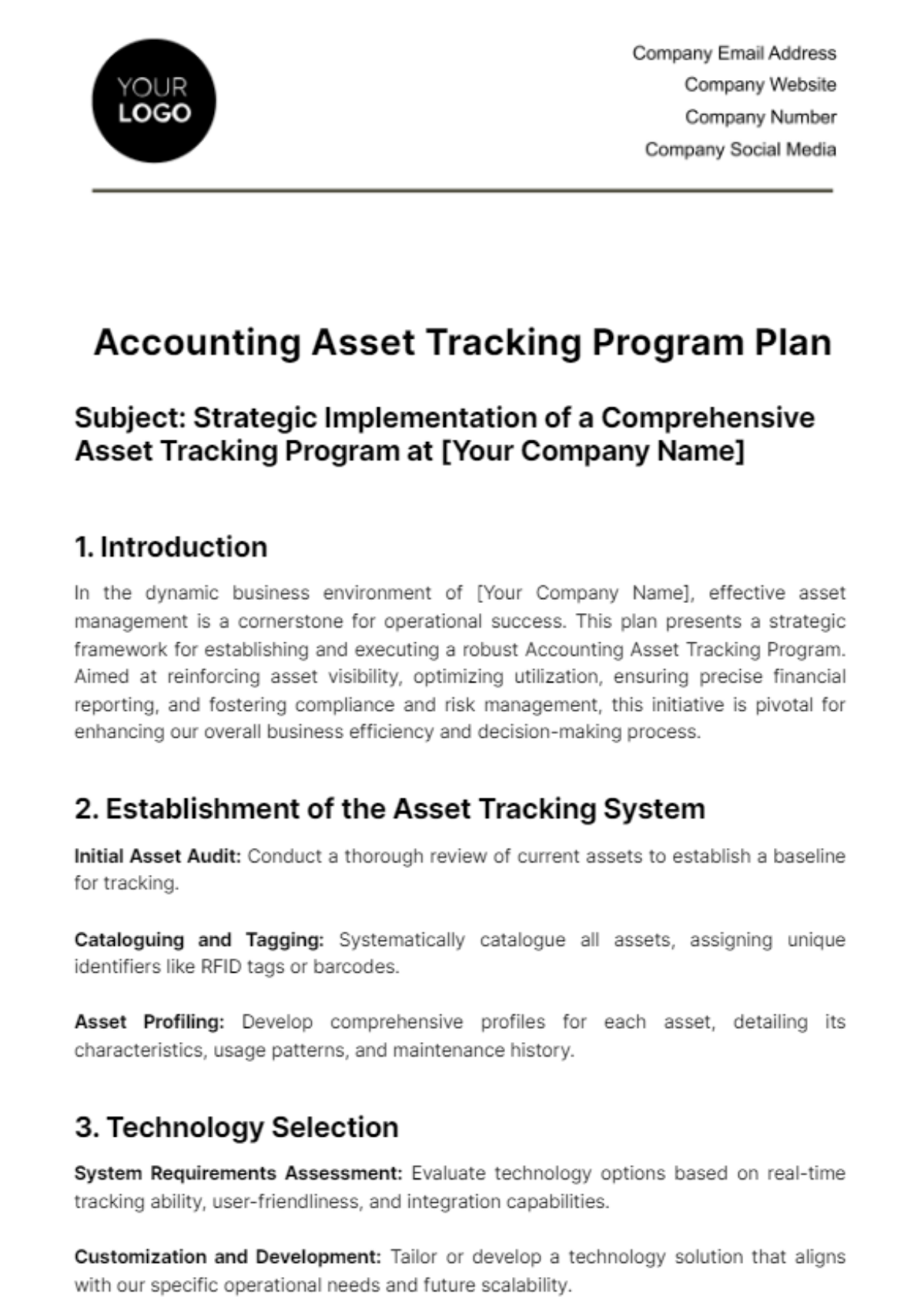Accounting Asset Tracking Program Plan
Subject: Strategic Implementation of a Comprehensive Asset Tracking Program at [Your Company Name]
1. Introduction
In the dynamic business environment of [Your Company Name], effective asset management is a cornerstone for operational success. This plan presents a strategic framework for establishing and executing a robust Accounting Asset Tracking Program. Aimed at reinforcing asset visibility, optimizing utilization, ensuring precise financial reporting, and fostering compliance and risk management, this initiative is pivotal for enhancing our overall business efficiency and decision-making process.
2. Establishment of the Asset Tracking System
Initial Asset Audit: Conduct a thorough review of current assets to establish a baseline for tracking.
Cataloguing and Tagging: Systematically catalogue all assets, assigning unique identifiers like RFID tags or barcodes.
Asset Profiling: Develop comprehensive profiles for each asset, detailing its characteristics, usage patterns, and maintenance history.
3. Technology Selection
System Requirements Assessment: Evaluate technology options based on real-time tracking ability, user-friendliness, and integration capabilities.
Customization and Development: Tailor or develop a technology solution that aligns with our specific operational needs and future scalability.
Vendor Evaluation and Selection: Rigorously assess potential vendors for reliability, support, and technological advancement.
4. Asset Allocation and Deployment
Efficient Asset Utilization: Utilize the tracking system to monitor asset deployment, aiming to maximize usage and minimize idle time.
Cross-Departmental Asset Sharing: Implement a system for sharing assets across departments to enhance overall resource efficiency.
Usage Analysis: Regularly analyze asset usage data to identify opportunities for reallocation or optimization.
5. Integration with Financial Reporting
Seamless Data Flow: Ensure the asset tracking system feeds directly into financial reporting tools for accuracy.
Depreciation Calculation: Automate depreciation calculations based on precise asset usage data.
Asset Valuation Accuracy: Improve the accuracy of asset valuation in financial statements through real-time data.
6. Regulatory Compliance and Risk Management
Compliance Adherence: Align the tracking program with accounting standards like GAAP or IFRS and other regulatory requirements.
Risk Identification and Mitigation: Incorporate features to quickly identify risks related to asset loss or misuse and implement mitigation strategies.
Audit Trail Creation: Maintain a detailed audit trail for each asset to support compliance and risk management efforts.
7. Maintenance and Lifecycle Management
Scheduled Maintenance Alerts: Implement alerts for regular maintenance based on usage data and manufacturer recommendations.
Lifecycle Analysis: Monitor and analyze asset lifecycle stages to plan for timely upgrades or disposals.
Performance Tracking: Track and evaluate asset performance over time to inform maintenance and replacement decisions.
8. User Training and Engagement
Comprehensive Training Programs: Develop and roll out training modules for staff on the effective use of the asset tracking system.
User Involvement and Feedback: Engage users in the implementation process and gather feedback for continuous improvement.
Performance Metrics: Establish and monitor performance metrics to encourage responsible asset management.
9. Data-Driven Decision Making
Strategic Insights Gathering: Leverage asset usage data to inform strategic decisions about asset management and procurement.
Trend Analysis: Analyze data trends to anticipate future asset needs and plan accordingly.
Report Generation and Analysis: Regularly generate and review reports for insights into asset performance and utilization patterns.
10. Scalability and Adaptability
Future-Proofing the System: Design the program to be scalable and adaptable to the evolving needs of [Your Company Name].
Modular Approach: Adopt a modular approach to the system to easily incorporate new technologies and features.
Regular System Reviews: Schedule periodic reviews of the system to ensure it continues to meet the changing requirements of the business.
11. Conclusion
This Asset Tracking Program Plan, crafted with strategic foresight, is a vital step towards enhancing the operational efficiency and financial accuracy of [Your Company Name]. By adopting this comprehensive approach, we position ourselves for sustained growth and success in a rapidly evolving business landscape.
Plan Created By:
[Your Name]
[Your Job Title]
[Your Company Name]
Accounting Templates @ Template.net






























